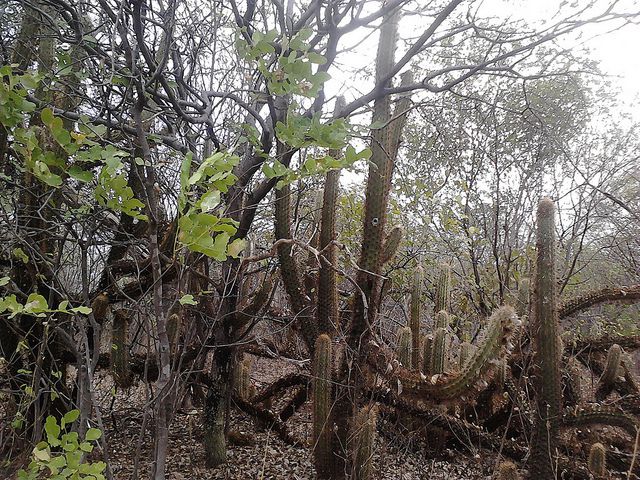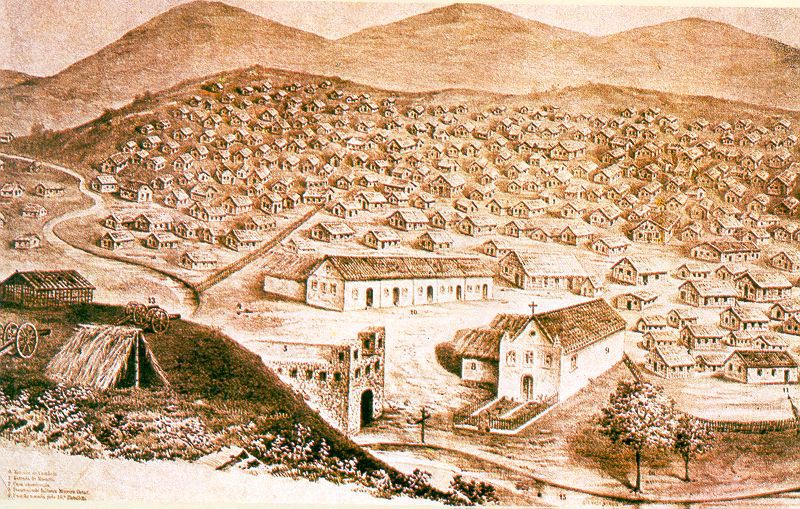
São Raimundo Nonato, July 22 — July 23
July 22 Shaky writing reflects not cachaça but start of 2500-kilometer bus trip from Brasília to São Raimundo Nonato, Piauí and then to Uaúa near Canudos.
Within an hour of leaving Brasília, it begins to hit the senses, this “openness” with only the smallest dents of civilization on it. It's curious that with so much land, there should be a chronic possesseiros problem...
Road is hard-top with “breaks” of red dust. Bus takes them at 50/60 km/h. Overtaking on blind rises, corners, banging across rough stretches: amusement of some passengers, terror of others. Cars with lights on. Vegetation is deep, dusty red, every leaf, tree trunk. Dust curtain for a hundred yards on either side. Windows closed because of dust. Hot! Deviations (Desvio!) left and right. Telephone lines draped on tree branches. Vast ranches. Dust covered Brahman cattle. Road workers waving. Passing vehicles hooting. Long red vein to horizon. Strikes me as one of areas of “last great adventure.”

You don't know Brazil until you have sat with its people hour after hour, banging across dusty roads, nose blocked, throat parched, on and on through the day and night. Poverty stricken worker next to me. Says little. Half a tooth on upper jaw. Dust-stained white linen bag with possessions. Dress of same material.
July 23 7 a.m. “Asfalt!” Acclamation through bus after night on dirt. Road still primitive. Drifts, no bridges, taken at healthy speed. Remote “All Night” road stop. Ghastly meal. Outside, incongruous sight of attractive girl, a fazendeiro's daughter and his sons with brand-new tractor that won't start.
Old man in pink trousers and grandson sit next to me.
8.15 a.m. Start of true sertão. Green now but you can easily imagine it in a drought. Flat-topped table hills, eroded, red sand. Simple house of mud and palm thatch.
12.30 p.m. Looks as if trip to first point shorter than expected. A mere 24 hours! Delighted by prospect since glance at motorista in his rear view mirror shows him battling to stay awake. Madre Deus!
July 24 And now for something completely different. Arrived at São Raimundo Nonato at 5 p.m. yesterday. Palace Hotel room = something like old stable, no glass window, overlooking morass. Realize that I've been awake/traveling for 48 hours. Go to buy pen at shop. Owner refuses to take my money. Say thanks and go down street. Followed by car. It's the guy who gave me the pen. Asks if I want to have a beer. Joined by João Raimundo, fourth year law student who speaks perfect English. Sit talking at outside table, watching people begin to gather outside Palace Hotel. Suddenly town lights fail and we sit in darkness. Lights come on and reveal crowd outside hotel entrance.
The reason: “Lady Di” has arrived from São Paulo coming to sing for the locals!
They wait eagerly and so do I until midnight when at last “Lady Di” appears at hotel entrance and walks grandly over to next-door disco for her performance.
The “disco” is open, unroofed, more like a basketball court with three hundred people jammed into a hundred-by-fifty foot space. Chaos. Lady Di sings to the packed crowd. She could've been the real thing, so swept away were they. Her concert over, she is followed back to the hotel entrance by adoring fans. I also make my exit.
As I write up these notes, the live disco band is belting out a tune. God knows what time this will go on till. I fear Lady Di will make a second appearance at 2 a.m. - If these people can be so easily swayed by their great Lady Di, how much more by an Antonio Conselheiro!
I pray the lights fail in the next ten minutes. (They don't.)
Uauá and Canudos, July 25 — July 27
Arrive at Uauá to find contact arranged via Antonietta out of town for a week but within minutes his wife arranges for a family friend to take me to Canudos tomorrow.
Amusing introduction to Uauá in Hotel Gonçalves run by a mother and her five daughters. As word spreads, I find myself seated at table with twelve women of the town come to observe estrangeiro.
Hotel floor is divided into cubicle-like rooms with walls open at the top, the occupant of the room next to me snoring away happily all night.
July 25 - July 27. Two and a half days with no journal entry, through lack of time and place. Earlier efforts on bus inadequate/difficult and besides, bus-side observations in the sertão grow predictably similar. Which, in a way, is the point about the sertão: vast, repetitive, soulless backlands, mile upon mile of caatingas, close-packed, mind encroaching. Step into it a few meters from the side of the road and you are lost. It enfolds and absorbs you.

A visit to Canudos on Sunday provided as much as I wanted from the "present." There's a danger of getting put off track by too much modernism. I have strong impressions and ideas about Canudos and Antonio Conselheiro and my mind relates them to the 19th century. — What I behold in the 20th is a distraction and can only water down those impressions developed from reading and thinking. Preconceptions, if you will.
Curious aspect of Sunday was “Manoel” or to be more precise “Manoel Carlos Simoês de Almeida.” — I must remember the importance of names, the use of so many, especially when it comes to impressing estrangeiros.
Manoel is from Mozambique and left after independence. Within minutes of meeting him, he begged me not to mention “Moz” because, hand on heart, “it was too much for him,” and “all because of that bastard Samora Machel.” Manoel sells jewelry in the Brazilian sertão after “Moz” and Rhodesia (Zimbabwe,) where he was a linotype operator.
I don't know how many Manoels there are in this country but cannot see them doing anything to improve Brazilian race relations. Though first he wanted to avoid the subject, Manoel had more and more to say as the day progressed. Stories like the man who disowned his mother because she wrote from Portugal saying that he should come back to the motherland, but “bring nothing that you took from the blacks.” According to Manoel, the man wrote back to Senhora X saying from that time he did not consider her his mother. Manoel personally does not wish to tread the soil of Portugal because of the “traitors.”
Even as I traveled toward Canudos I had visions of this barren, wasted sertão where a mystic's most fervent ramblings could take easy root. Interpretations of Glauber Roche aside, the site of Canudos today lies beneath a barrage! A placid backwater with a small island where a few goats and sheep are rowed across to graze. Nothing, absolutely nothing, to suggest that 20,000 people died in this small valley, nothing to bring back the echo of the small cannon from a nearby hill or roar of big guns from the larger hill beyond, all wiped out.

Locals suggest that the flooding of the valley was a political move, but I'm skeptical. It was, so far as I know, commenced in 1953. At that time, the kind of political consciousness/ reappraisal/ revisionist tendency we have today was in its infancy. Few outsiders would have taken symbol of Canudos seriously.
Anyway, I got what I wanted, a soul-filling understanding of the terrain, of the small towns of the time, of the people. Was surprised by Mrs. Gonçalves (of hotel) reciting word for word a prayer said by an old man who'd survived Canudos. Though few beyond the area remember it, Canudos is still very much part of local folklore...
